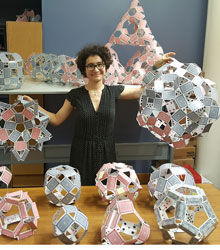Math Meets Art in Student’s FURSCA Project
Liliya Chernysheva, ’19, writes about her summer of polyhedra and discovery
October 11, 2016

Liliya Chernysheva, ’19, from Moscow, Russia, with her collection of playing-card polyhedra, created for her FURSCA project.
I have always been interested in both sciences and arts, but I could never find a way of combining my two passions. Choosing just one path always seemed to me like a terrible mistake. So it was great, this past summer, to work with math professor Dave Reimann on a mathematical art project, funded by the Foundation for Research, Scholarship and Creative Activity.
I spent the first part of my project learning about different types of polyhedra—three-dimensional objects made from geometric shapes. A soccer ball, made by stitching together a bunch of flat pentagons and hexagons, is one of 13 special polyhedra collectively called the Archimedean solids.
Next I made physical constructions of polyhedra, which in theory have perfectly flat faces, perfectly straight and infinitely thin edges, and precise angles. In reality, we can only approach perfection. I substituted rectangular plates for the polyhedral edges. Each individual plate was connected to other plates at their corners using small fasteners. In theory, this process will not generally result in a strictly polyhedral form. But in practice, flexible plates will produce a new form that has similar properties to the starting polyhedron.
I had to find construction materials that were rigid enough to hold shape, flexible enough to conform, and low cost. Looking at some of Dr. Reimann’s earlier research, I settled on playing cards. We drilled a hole in each corner and assembled the polyhedral forms with split-pin fasteners. Usually it took me a minute per every four to six cards to connect. Archimedean solids have 18 to 180 edges, and some other objects I created contained several hundreds of cards.
Thinking Outside the Cube
When it comes to three-dimensional forms, usually the most we can think of include the sphere, the cube, the cone, and the cylinder. Archimedean, Platonic, and many other polyhedral forms are mostly unknown outside of mathematics, which makes them so interesting to study. These constructions are relevant to various sciences, creating new approaches to things that have been previously studied.
One scientific area outside of mathematics that uses polyhedral forms is chemistry. For instance, it is well known that some viruses have an icosahedral structure. Understanding the underlying geometry can help us understand viruses. The family of molecules known as Fullerenes (named for Buckminster Fuller, inventor of the geodesic dome) also have an underlying polyhedral structure.
Even the artist M. C. Escher, known for his drawings of symmetrical patterns, also included complex polyhedral forms in some of his artwork.
What fascinates me the most about these polyhedra is that sometimes certain forms are built first and then their prototypes are found in nature. For example, Pagodane, an organic compound synthesized in 1987, was named for its pagoda-like structure. Sometimes we can invent what we discover!
A Theory Emerges
As I might have expected from doing this project, I got better at visualizing three-dimensional objects and can now better predict the characteristics of a shape of a theoretical polyhedron without physically constructing it.
Something I didn’t expect was discovering that I do like symmetry. Whenever I drew or danced I always preferred asymmetry, so that a viewer always stays engaged. Now I understand the beauty of symmetrical patterns and the mathematics behind them, and am eager to create something symmetric of my own.
Dr. Reimann and I were also able to develop a mathematical theory, which determines the flatness of a chosen pattern. We are also confident that by changing the length of certain plates, flatness can be achieved without any bumps and craters. We are interested in flatness because we believe that bent cards tend to slowly collapse under weight, whereas flat structures are more rigid. In order to prove or disprove this statement I am going to construct cylinders from bumpy tessellations. Since most of them have interesting, unusual patterns, I am curious to see how we can cap off those structures.
Applications of the structures I built can be found in architecture (playgrounds), chemistry (virology, metal organic frameworks) and art. I finally found a way where the art and math intersect, and perhaps there are many more “intersections” that I just do not know about yet!

